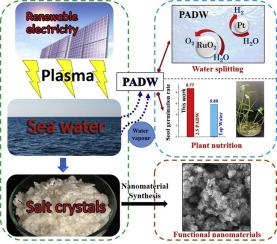当前位置:
X-MOL 学术
›
Sustain. Mater. Technol.
›
论文详情
Our official English website, www.x-mol.net, welcomes your feedback! (Note: you will need to create a separate account there.)
Atmospheric-pressure plasma seawater desalination: Clean energy, agriculture, and resource recovery nexus for a blue planet
Sustainable Materials and Technologies ( IF 9.6 ) Pub Date : 2020-09-01 , DOI: 10.1016/j.susmat.2020.e00181 U.G. Mihiri Ekanayake , Dong Han Seo , Konstantin Faershteyn , Anthony P. O'Mullane , Hokyong Shon , Jennifer MacLeod , Dmitri Golberg , Kostya (Ken) Ostrikov
Sustainable Materials and Technologies ( IF 9.6 ) Pub Date : 2020-09-01 , DOI: 10.1016/j.susmat.2020.e00181 U.G. Mihiri Ekanayake , Dong Han Seo , Konstantin Faershteyn , Anthony P. O'Mullane , Hokyong Shon , Jennifer MacLeod , Dmitri Golberg , Kostya (Ken) Ostrikov

|
Abstract Water connects every aspect of life. Only 4% of the world's water is fresh water, as most water sources have different degrees of salinity. As a result, billions of people face water scarcity, which is a global challenge. Desalination technologies that separate fresh water from solvated salt ions in saline water are attracting major attention. However, conventional desalination processes including thermally and pressure driven processes are highly energy intensive. To address this issue we demonstrate that the atmospheric-pressure plasma (APP) treatment of saline water can be a new potential alternative low-energy and green desalination route. Valuable salts are recovered by direct salt crystal precipitation within a short plasma processing time. During desalination and salt precipitation, plasma activated desalinated water (PADW) is generated and can be used for clean energy processes such as water electrolysis and sustainable agriculture by enhanced plant seed germination. In addition, functional nanomaterials can be extracted from the precipitated salt. The PADW exhibited a low salinity of 5.6 mS/cm with a low pH value of 2.1. The unique intrinsic PADW chemistries enabled electrochemical water splitting for both the hydrogen evolution reaction (HER) at a Pt electrode and the oxygen evolution reaction (OER) at a RuO2 electrode. Moreover, the feasibility of using PADW in sustainable agriculture was demonstrated by enhancing mungbean seed germination using tap water mixed with PADW. At optimum mix concentration, both seed germination rates and germination percentages increased. Finally, we demonstrated the feasibility of synthesizing high-value 2D nanomaterials exemplified by Mg(OH)2 nanosheets via a single step thermal process using the salt precipitated from the seawater by the plasma process. Combined with straightforward use of renewable electricity to generate APPs, this study reveals the plasma potential for sustainable recovery of clean water, clean energy applications, sustainable agriculture, and manufacturing of advanced functional nanomaterials – all from the greatest treasure of our blue planet – seawater.
中文翻译:

大气压等离子海水淡化:蓝色星球的清洁能源、农业和资源回收关系
摘要 水连接着生活的方方面面。世界上只有 4% 的水是淡水,因为大多数水源都有不同程度的盐度。结果,数十亿人面临水资源短缺,这是一个全球性挑战。将淡水与盐水中的溶剂化盐离子分离的脱盐技术引起了人们的极大关注。然而,包括热驱动和压力驱动过程在内的传统脱盐过程是高度能源密集型的。为了解决这个问题,我们证明了盐水的常压等离子体(APP)处理可以成为一种新的潜在替代低能量和绿色脱盐路线。在较短的等离子体处理时间内,通过直接盐晶体沉淀回收有价值的盐。在海水淡化和盐析过程中,产生等离子活化淡化水 (PADW),可用于清洁能源过程,例如水电解和通过增强植物种子发芽的可持续农业。此外,可以从沉淀的盐中提取功能性纳米材料。PADW 表现出 5.6 mS/cm 的低盐度和 2.1 的低 pH 值。独特的本征 PADW 化学物质能够为 Pt 电极的析氢反应 (HER) 和 RuO2 电极的析氧反应 (OER) 实现电化学水分解。此外,通过使用与 PADW 混合的自来水促进绿豆种子发芽,证明了在可持续农业中使用 PADW 的可行性。在最佳混合浓度下,种子发芽率和发芽率均增加。最后,我们证明了使用等离子体工艺从海水中沉淀的盐,通过单步热工艺合成以 Mg(OH)2 纳米片为例的高价值 2D 纳米材料的可行性。结合直接使用可再生电力来生成 APP,这项研究揭示了等离子体在可持续回收清洁水、清洁能源应用、可持续农业和先进功能纳米材料的制造方面的潜力——所有这些都来自我们蓝色星球的最大宝藏——海水。
更新日期:2020-09-01
中文翻译:

大气压等离子海水淡化:蓝色星球的清洁能源、农业和资源回收关系
摘要 水连接着生活的方方面面。世界上只有 4% 的水是淡水,因为大多数水源都有不同程度的盐度。结果,数十亿人面临水资源短缺,这是一个全球性挑战。将淡水与盐水中的溶剂化盐离子分离的脱盐技术引起了人们的极大关注。然而,包括热驱动和压力驱动过程在内的传统脱盐过程是高度能源密集型的。为了解决这个问题,我们证明了盐水的常压等离子体(APP)处理可以成为一种新的潜在替代低能量和绿色脱盐路线。在较短的等离子体处理时间内,通过直接盐晶体沉淀回收有价值的盐。在海水淡化和盐析过程中,产生等离子活化淡化水 (PADW),可用于清洁能源过程,例如水电解和通过增强植物种子发芽的可持续农业。此外,可以从沉淀的盐中提取功能性纳米材料。PADW 表现出 5.6 mS/cm 的低盐度和 2.1 的低 pH 值。独特的本征 PADW 化学物质能够为 Pt 电极的析氢反应 (HER) 和 RuO2 电极的析氧反应 (OER) 实现电化学水分解。此外,通过使用与 PADW 混合的自来水促进绿豆种子发芽,证明了在可持续农业中使用 PADW 的可行性。在最佳混合浓度下,种子发芽率和发芽率均增加。最后,我们证明了使用等离子体工艺从海水中沉淀的盐,通过单步热工艺合成以 Mg(OH)2 纳米片为例的高价值 2D 纳米材料的可行性。结合直接使用可再生电力来生成 APP,这项研究揭示了等离子体在可持续回收清洁水、清洁能源应用、可持续农业和先进功能纳米材料的制造方面的潜力——所有这些都来自我们蓝色星球的最大宝藏——海水。


























 京公网安备 11010802027423号
京公网安备 11010802027423号